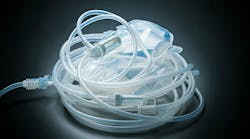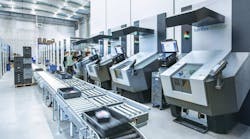A pharmaceutical cold chain can break down at multiple points between the manufacturer and the consumer. Inconsistent temperature control during shipment or inside the warehouse are two common causes of product degradation, as are pallets of product sitting out on an open dock. Considering the value of a refrigerated pharmaceutical shipment, any glitch in a cold chain’s integrity can become an immensely expensive mistake.
Not surprisingly, a wide variety of high-tech equipment has been developed for cold transport in recent years, from thermal-release packaging and nitrogen vapor tanks to remotely monitored reefer trucks, trains, planes and ships. In the warehouse, some of the biggest technological advancements have taken place in the cooler/freezer door category and in loading dock design.
A significant paradigm shift regarding cooler and freezer doors has occurred recently. In the eyes of many facility managers, heavy, slow-moving, high R-value doors have been displaced as the “gold standard” by lighter, high-speed doors — particularly in high traffic areas. At the loading dock, state-of-the-art design is now defined by “drive-through” setups, which reduce the opportunity for outside air to get in or conditioned air to get out, thus helping pharmaceutical manufacturers better control their cold chain.
The right door for cold operations
Inside the plant, doors play a critical role in maintaining temperature separation, which is a key to product integrity. As many facility managers will attest, it can be difficult to find doors that meet the regulations required for critical environments — especially those in pharmaceutical manufacturing plants. However, beyond just being up to code, high-speed doors in a pharma cold chain must also deliver quick enough cycle times to ensure that delicate products in temperature-controlled areas aren’t ruined by outside air infiltration when forklifts go in and out.
Pros and cons of traditional freezer doors
The traditional way to approach refrigeration was to install heavy, insulated, rigid doors with a high R-value. After all, refrigerated spaces are designed to trap cold inside and keep heat and humidity out. While great in low-traffic areas, when placed in high-traffic areas, these slow-moving, side-acting doors result in longer door cycle times and higher rates of air infiltration.
Having a slow-moving door makes temperature control inside the freezer difficult. Conventional hard-core doors are susceptible to forklift damage, which can lead to substantial energy loss as a result of poor sealing. Consequently, for high-traffic openings, energy loss due to the door being open or improperly sealed can represent a significantly larger cost.
In some instances, depending on the application, these slow-moving doors do not meet the hygienic standards mandated by the pharmaceutical industry.
Folding doors or low R-value, high-speed doors are sometimes selected as an alternative to minimize air infiltration in non-critical areas. However, some models have poor sealing characteristics or an R-value too low to prevent frost from building on the door panel surface itself, which commonly leads to purchasing heat lamps or air curtains for the doors at an annual operating cost of $10,000 or more.
Air systems can be either stand-alone or housed in multiple units integrated into a vestibule assembly. Often, these systems do not seal the opening well, and proper alignment is critical for best performance. Vestibules can also require a large footprint, eating up valuable floor space.
Air units generally consist of heaters that reduce the relative humidity (RH) of the infiltrating air. Unfortunately, it usually takes a tremendous amount of energy for them to operate at a level that keeps the opening free of ice and frost.
Overall, these high costs have driven demand for better options.
High-speed doors trending up
The biggest advantage high-speed doors offer in pharma-oriented cold operations is in their name – high speed. While doors with high R-values offer better temperature separation when closed, their slower operating speeds are detrimental in facilities that maintain regular traffic between spaces.
Because many cold operations require frequent material handling operations, doors with slightly lower R-values that reduce air infiltration with fast cycle times become more practical. This is true in most pharmaceutical operations that don’t utilize deep freezers. The most advanced high-speed doors offer superior sealing power to maintain temperature differentials when closed.
Bi-parting doors
Many pharmaceutical facilities use bi-parting doors made from stainless steel or fiberglass. However, new-age doors are made from a heavy-duty 40-oz. PVC curtains can provide the same type of benefits as those standard doors. The material is smooth enough to minimize the harborage of dust and particulates, aligning it with guidelines set by the U.S. Food and Drug Administration (FDA) and current Good Manufacturing Practices (cGMP).
Side frames for these PVC-curtain doors are made from stainless steel for compliance with industry standards. The most advanced doors in this category include a spring tube design that minimizes the footprint on either side of the door. Some even feature an obstruction-sensing reverse system that protects employees and equipment going through the door opening.
Additionally, the light-weight fabric allows doors to open and close faster for maximum environmental control. Coupled with a variable frequency drive motor in advanced models, bi-parting doors can operate at speeds of up to 120 inches per second when opening and 40 inches per second when closing.
Upward-acting doors
Bi-parting doors aren’t the only option in the pharmaceutical industry. Many facilities are finding benefits — like a decreased footprint — with upward-acting “roll-up” doors. A rigid-panel center-opening door spanning a 6-foot-wide opening requires approximately 3 feet of wall space on each side when its panels open, while a roll-up door doesn’t require any, since its fabric “curtain” collects in a head assembly at the top of the door when opened.
The newest generation of roll-up doors features anti-microbial materials and other cleanroom upgrades. These new features, coupled with their tight sealing and high cycle speeds, are reasons they are catching on with pharmaceutical facility managers. State-of-the-art high-speed door models can move at up to 100-inches per second, minimizing air infiltration while increasing productivity.
Faster doors also mean less opportunity for material handling operators to run into the doors, too. In the rare event that a high-speed, roll-up door is struck, the door can break from its tracks and then re-align when rolled back up. In contrast, traditional slow-moving rigid doors are much more susceptible to forklift damage. This can lead to improper sealing and breaks in the cold chain. Additionally, many high-speed doors come with LED countdown systems that reduce the likelihood of an impact by enhancing safety and communication at the door opening.
Wash-down, anti-microbial and cleanroom doors
A new generation of high-speed doors has come on the market in recent years, featuring wash-down capabilities and anti-microbial materials, making them ideal for use in pharmaceutical industries.
High-speed doors play an essential role in maintaining clean operations and product integrity. They are designed to address facility needs for environmental control, productivity, and safety (as well as cleanliness). In cleanroom applications, they are used not only to prevent cross-contamination, but also to help maintain correct room pressures, air circulation rates, and optimal operating efficiency.
FDA cleanroom standards outline recommendations and requirements for manufacturers. The starting point is to look for doors compliant with cGMPs, FDA, and the United States Department of Agriculture (USDA).
Two key considerations for any door configuration are ease of cleaning and durability. In all cases, these doors must be able to stand up to repeated cleaning with chemical solvents and have a smooth, non-porous surface resistant to microbial and fungal growth. Doors should also have tapered surfaces and edges that essentially eliminate harborage of dust or other contaminants and possess no sharp angles to minimize the harborage of microbes. Additionally, they should:
- be corrosion-resistant (which is often a problem with older door systems);
- use stainless steel side frames and shrouds; and
- incorporate a lubrication-free design since lubricants can attract particulates.
It is also advisable to avoid doors with exposed fasteners and coils, as they will take longer to clean and could harbor contaminants. While maintaining the cold chain is critical for many pharmaceutical manufacturing plants, cleanliness remains paramount.
A drive-through setup is ideal
Cleanliness and maintaining the cold chain are important at the loading dock. A drive-through application allows pharmaceutical manufacturing facilities to meet both of those standards. This method enhances cold chain and supply chain integrity because security seals are only broken inside facilities. In addition to the proper dock shelters, a drive-through setup requires a system of equipment that works together.
The loading dock leveler is the key to this drive-through setup. The leveler is designed to create a smooth bridge from the trailer to inside the facility (and back) as a matter of operational safety and efficiency. While traditional levelers perform this function admirably, not all types allow for drive-through capabilities; a vertical-storing leveler can.
Unlike a pit-style leveler, a vertical leveler (when in the stored position) allows the loading dock door to close directly on the pit floor instead of on the leveler. This difference means fewer gaps for outside air to get inside temperature-controlled operations. It also effectively reduces energy lost by minimizing outside air infiltration.
As part of a drive-through, the vertical leveler allows the driver to back completely to the loading dock and stay inside the cab (boots off the ground). Then the dock personnel can secure the trailer by operating the restraint from the control panel inside the loading dock before opening the trailer doors inside the building and breaking the security seal. This process keeps the conditioned air inside the facility to maintain the cold chain, while keeping out possible contaminants like dust, debris and pests from entering the loading dock area.
Additionally, the vertical design makes it easy to clean or wash down the pit floor when the leveler is in the upright and stored position. With motion sensors in the pit area, an additional layer of pedestrian safety can be added for personnel performing maintenance on the leveler. And since ease of cleaning is a major component of sanitary transport rules, this type of leveler is recognized as a major upgrade in cGMPs.
Maintain product integrity with the set-up
Pharmaceutical manufacturing facilities are constantly challenged to maintain product integrity by completing the cold chain and keeping all areas clean. When evaluating what type of door to implement in an operation that requires low temperatures, it’s important to select one that meets both tests. The same is true for the loading dock setup.
In most instances, using advanced high-speed doors inside the plant and a drive-through setup at the loading dock can help facility managers maintain the cold chain and meet pharmaceutical industry standards.






